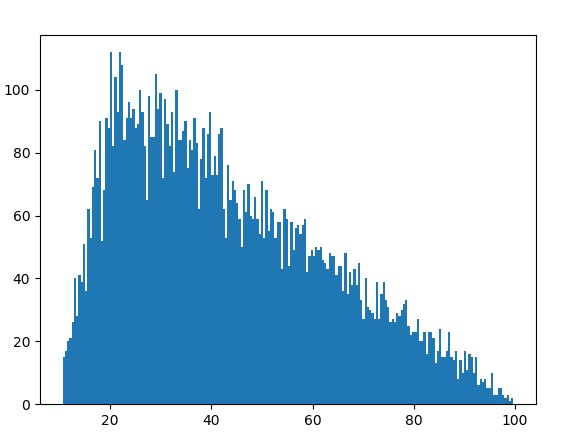triangular()是内置的方法random模块。它用于返回一个偏向一个极端的范围内的随机浮点数。
用法: random.triangular(low, high, mode)
参数:
低:随机数的下限
高:随机数的上限
模式:附加偏差;低<模式<高
如果参数为(10、100、20),则由于存在偏差,生成的大多数随机数将接近于10,而不是100。
返回值:随机浮点数
范例1:
# import the random module
import random
# determining the values of the parameters
low = 10
high = 100
mode = 20
# using the triangular() method
print(random.triangular(low, high, mode))输出:
22.614510550239572
范例2:如果我们多次生成该数字,则可能可以确定偏差。
# import the random module
import random
# determining the values of the parameters
low = 10
high = 100
mode = 20
# running the triangular method with the
# same parameters multiple times
for i in range(10):
print(random.triangular(low, high, mode))输出:
58.645768016894735 46.690692250503226 33.57590419190895 52.331804090351305 33.09451214875767 12.03845752596168 32.816080679206294 20.4739124559502 82.49208123077557 63.511062284733015
范例3:我们可以通过绘制图形来可视化三角形图案。
# import the required libraries
import random
import matplotlib.pyplot as plt
# store the random numbers in a list
nums = []
low = 10
high = 100
mode = 20
for i in range(10000):
temp = random.triangular(low, high, mode)
nums.append(temp)
# plotting a graph
plt.hist(nums, bins = 200)
plt.show()输出:

相关用法
- Python os._exit()用法及代码示例
- Python os.WEXITSTATUS()用法及代码示例
- Python os.abort()用法及代码示例
- Python os.renames()用法及代码示例
- Python os.lseek()用法及代码示例
- Python calendar formatmonth()用法及代码示例
- Python PyTorch sin()用法及代码示例
- Python Sympy Line.is_parallel()用法及代码示例
- Python PIL GaussianBlur()用法及代码示例
- Python range()用法及代码示例
- Python Numpy np.hermefit()用法及代码示例
- Python Numpy np.hermevander()用法及代码示例
注:本文由纯净天空筛选整理自Yash_R大神的英文原创作品 random.triangular() method in Python。非经特殊声明,原始代码版权归原作者所有,本译文未经允许或授权,请勿转载或复制。
